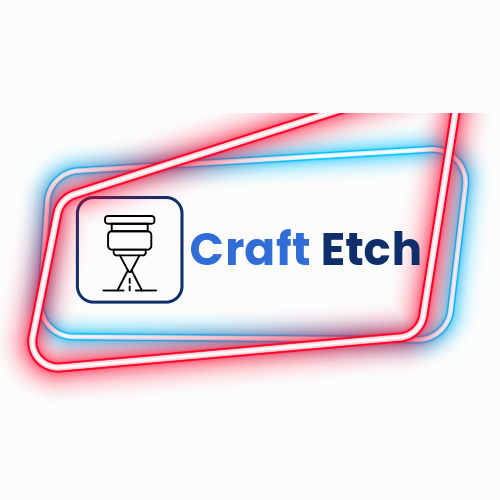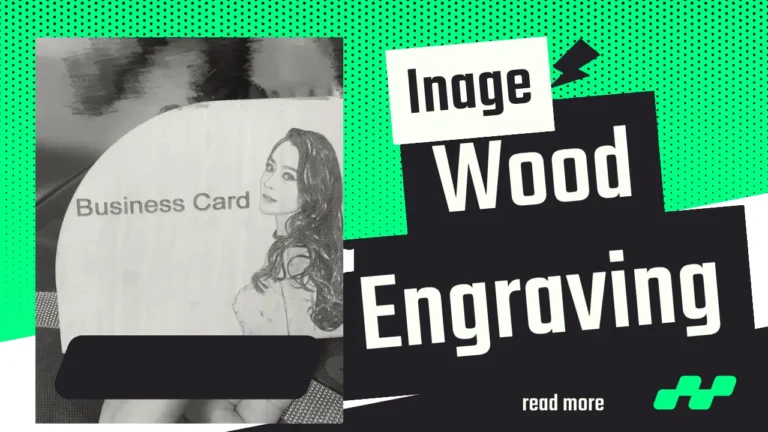Join Workshops
Physical Address
304 North Cardinal St.
Dorchester Center, MA 02124
6 Best Handheld Laser Engravers
Portable lasers are available in the price range of $600 to $2500. The price varies depending on the power and material adaptability. Most people choose a portable diode + infrared laser for larger material compatibility while some people still prefer portable fiber lasers for metal engraving only.
Over the past few years, the laser engraving market has been snowballing, which has helped us to experience some of the finest portable laser engravers, such as xTool F1 and Laserpecker lasers.
This article aims to deliver the readers with in-depth research & recommendations of the best handheld laser engravers and other technical assistance.
Top Small Handheld laser engravers
These are the best portable laser engravers suitable for almost all types of material engraving:
- xTool F1 dual laser (Best Overall for all material types)
- ComMarker B4 (Suitable as a small handheld metal marking station)
- LaserPecker LP4 IR + diode laser
- Enjoywood 2 in 1
- Atomstack M4
- Sculpfun Icube

Comparison of the popular portable lsers
We recommended the aforementioned laser engravers based on tests, user interviews, and thorough research.
Before recommending the items, we assessed each one’s capacities, portability issues, power, precision ability, laser type, and respective compatibility. Below is our quick comparison, which will further guide you to the in-depth review of each item.
| Laser Power | Engraving Speed | Suitable for | Best Side | |
| xTool F1 | 10 W (Diode) & 2 W (IR) | 4000mm/s | All materials | 360-degree rotation |
| ComMarker B4 | 20W – 100W Fiber laser | 15000 mm/s | Metal | A portable metal marking station |
| Laserpecker 4 | 10 W (Diode) & 2 W (IR) | 2000mm/s | All materials | 360 degree rotation |
| Enjoywood | 100 W (Diode) & 2 W (IR) | 12mm/s | Metal & plastics | Enrgaves fast on metal |
| Atomstack M4 | 20 W IR laser | 12mm/s | Metal & plastics | It’s a mini fiber laser for metal marking |
| Sculpfun Icube | 3W/5W/10W Diode laser | 167 mm/s | Wood, MDF, Acrylic | Low price, available below $300 |
Let’s discuss which handheld laser engraver is right for you!
We have chosen the xTool F1 as the best overall for the following reasons:
- It engraves faster than LaserPecker, Enjoywood & Atomstack.
- It weighs less than the Laserpecker LP4 and Atomstack.
- You can carry and perform remote operations with the Jackery power station having 9 hours of continuous power backup.
- Only the xTool offers an AI image editing facility (through XCS) that enables background removal and other image editing facilities using both the smartphone and PC which is missing in the other laser engravers.
- The F1 can perform both engraving and annealing whereas the Laserpecker does the same but with slightly inferior quality.
- Lastly, F1’s manufactuers provide carrying hard case that is not available with the comparing laser machines.
Considering mainly the portability, power backup, carrying facility, and diverse material compatibility F1 seems to be the top-of-the-notch portable laser machine in our opinion.
If you are a crafter or a laser engraving enthusiast then the xTool F1 and LaserPecker’s LP4 should be your priority because these laser engravers can do laser cutting, laser engraving, and laser marking in stainless steel and aluminum using their additional IR laser which uses a laser source at 1064 nm wavelength.
Additionally, the aforementioned laser engravers are good for multi-tasking, such as the xTool F1 and LaserPecker LP4 can be used for batch processing using their extension slide and rotary axes. The Laserpecker LP4 is special because this is the only laser engraver that rotates at any dimension depending on the size and position of the working material that no other handheld laser engraver does.
However, we suggest ComMarker B4 as a portable metal marking station if you intend to perform metal engraving only. The ComMarker has been really good and offers industrial grade metal marking with its true fiber laser ranging from 20W to 100W in portable version.
Moreover, if you only have to look for a handheld portable laser engraver only to place laser marking as per your need, the Atomstack M4 and Enjoywood can be your ultimate option. These two laser engravers only act as handheld laser to engrave just anything since there is a 20W IR laser whereas the xTool F1 , and LP4 use a 2W IR laser.
Remember, The Atomstack cannot do laser engraving more than 70 mm and it cannot rotate for you like the LaserPecker LP4. Neither Enjoywood nor the Atomstack can offer you simultaneous use of two laser sources like the LP4.
Lastly, if you are a budget buyer, the Sculpfun Icube can be a good option as it is available under $300 with great engraving capacity. But, sculpfun is not suitable for large scale works and it is not as powerful like the xTool and ComMarker.
Below is our in-depth review which explains each of the facts regarding the suitable handheld laser engravers.
xTool F1 (Best Overall for all material)
xTool f1 is the 2023’s fastest handheld laser engraver, using galvo technology, having 4000 mm/second engraving speed. This tiny portable laser engraver is available as the standalone version, or you may choose the slide extension, smoke purifier, and rotary attachments. The SKU offers you the choice so what to buy and what’s not so that the user can go for the right thing considering his budget.

The price starts from somewhere between $1700 to $2500, depending on the add-ons. The speed of 4000 mm/s blew our minds because this can be considerably treated as eight times higher than the average today. Using its 100% power at even 2000 mm/s speed, you can engrave base wood in 20 seconds, which typically requires more than 1.2 minutes in other Chinese engravers. This insane amount of speed became possible because the F1’s internal mechanism switches the laser beam automatically from the X-axis to the Y-axis through its intelligent galvanometer at no additional time. So, the laser power itself does not make the difference, but its intelligence does.
The accuracy (alternatively known as precision) of 0.002 helped the F1 to stand above all its competitors, which depicts that a picture engraving would offer you to look for maximum details in the material. For example, any tiny line or pattern of a single hair will become visible if the xTool f1 does the laser engraving.
The F1 is a handheld laser engraver that allows you to carry this machine and place it over the material you would love to engrave. In our opinion, the F1 is the winner of the battle of portable engravers because it gives you the freedom to engrave anything.
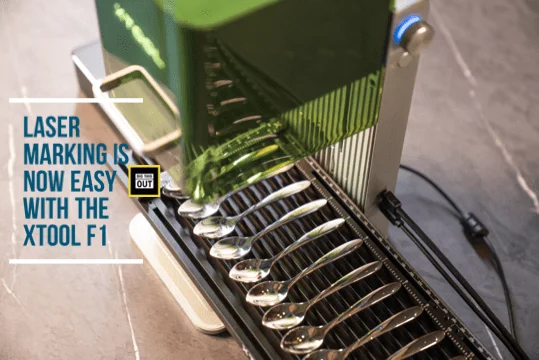
There are two lasers, one being a 10-watt blue diode laser and another being a 2-watt infrared laser. The 10-watt diode laser generates light at 455 nm wavelength while the other creates 1064 nm infrared rays. Such a combination of lasers offers the users ultimate freedom of engraving everything. For instance, with this portable handheld engraver, you can engrave wood, acrylic, glass, granite, and even stainless steel.
Below is an example of engraving materials suitable for each laser type:
| 10W diode laser | 2W IR laser |
| Wood | Stainless steel |
| Acrylic | Rock |
| Leather | Titanium |
| Fabric | Gold |
| Glass | Aluminium |
| Paper | Plastic |
| Rock | Silver |
What else differentiates the F1?
Apart from the high engraving speed, laser power, and compatibility, there is something else that helps the xTool F1 to be different from its competitors.
Let’s have a look at a watch engraving done by the xTool F1:
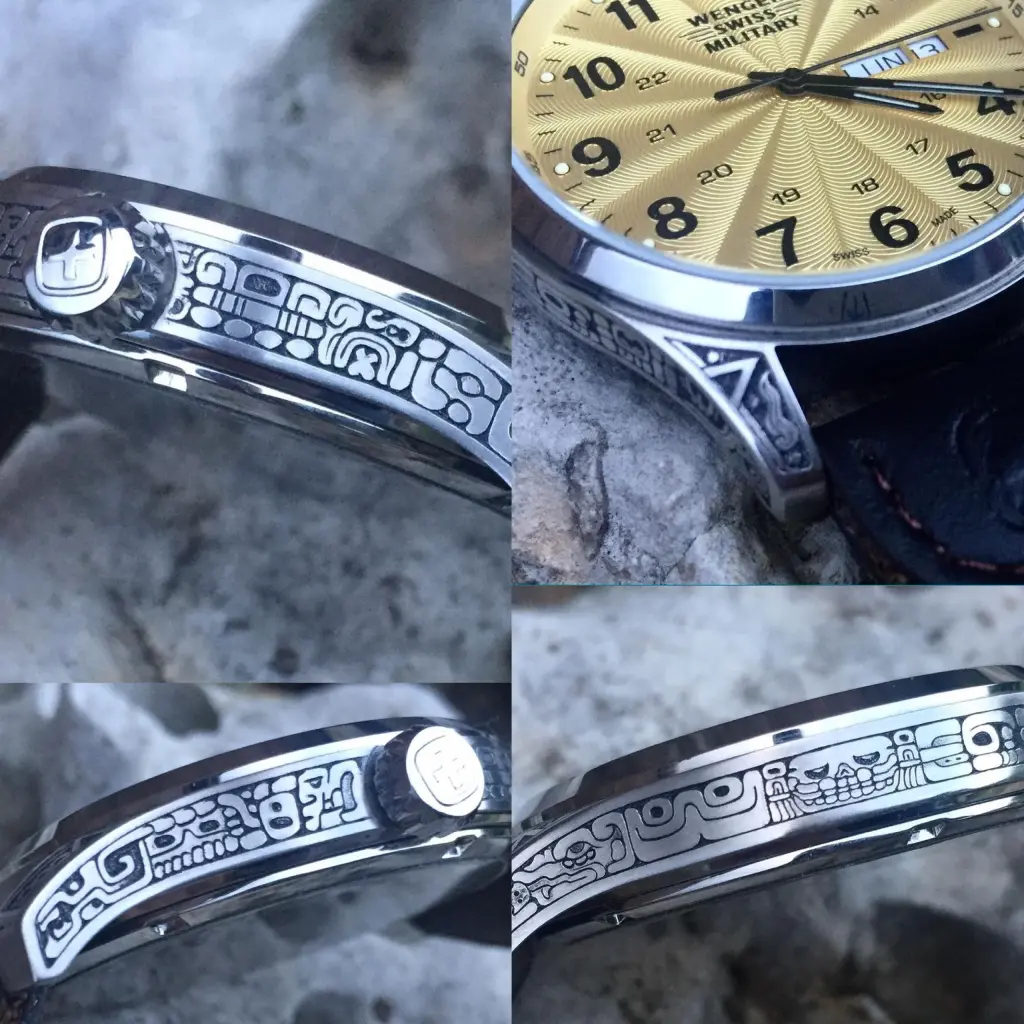
Let us first talk about its preview speed. The F1 comes with one one-click preview feature with a preview speed of 12000 mm/s (scan) and 8000 mm/s (outline). Since it’s a handheld laser engraver, a higher preview speed is very useful in ensuring the position accuracy & engraving precision. In simple words, F1 shows the replica preview on its upper screen, which helps the user to understand what’s going on underneath. Moreover, the preview speed of F1 is way above what LaserPecker offered for their earlier versions having 8858 inches per minute.
Besides, focusing flexibility is a great introduction by the F1 which allows you to set both auto and manual focus for the engraving works. In the early days, laser engravers struggled to set focus while the variable depth of material was used for engraving. This problem not only harmed the efficiency of engravings but also destroyed the said precision or accuracy level resulting in negative user experiences as well. In F1, it doesn’t even matter if you are feeding a quarter-inch thick wood or a 5-inch thick wood for engraving. The machine itself detects the laser head distance and sets the focus automatically as per the accuracy level of 0.002 mm.
As said earlier, the F1 comes with other amazing features while being a handheld laser engraver. For example, there is a protective shield that fully makes the machine laser leakproof. This machine is a portable version that still protects the surroundings from harmful laser rays. In addition, the user can set their password to stop unauthorized access to this laser machine. It directly affects the safety of other people in the family.
An intelligent smoke and overheat detection feature is there that ensures further health & safety concerns. However, the smoke purifier would cost much as this is offered at a higher price.
Let’s have a look at another pair of laser engravings done by xTool F1:

Technical Flexibility
The xTool F1 runs perfectly well with Lightburn and xTool Creative Space, offering users the ultimate flexibility to work from any platform. Thank god that does not operate in a cloud system like the Glowforge laser engravers that require a constant internet connection to run the machine.
Besides, both the control software would support JPG, PNG, SVG, DXF, and BMP files creating a more flexible pattern of laser engraving experience.
Key Takeaways
These are the key takeaways of xTool F1 handheld laser engraver:
- It’s a portable laser machine with a fully protective shield that eliminates the need to wear protective glass.
- Two laser modules is attached that offer laser engraving for sensitive materials such as Gold, Silver, and titanium which saves time and maximizes efficiency. As a reference, you may look at Embrace Making’s metal wallet engraving done with the F1
- Engraving Speed is very high, 4000 mm/s (100% higher than the Laserpecker) which contributes in faster engravings, especially if you need to engrave too many items within a short time.
- It offers a Precision of 0.002 mm, which is 100% higher than the Atomstack M4, which ensures that the tiniest lines or dots will be visible at the highest accuracy.
- Upgradable with bed extension, rotary, and smoke purifier, which are not available with Enjoywood 2 in 1. (this is a major part that makes F1 compete with large desktop engravers with batch processing ability.
- It comes under a $2000 budget, which is very competitive.
- The power station is available with 9 hours of backup (at a higher cost)
- Carrying hard case available for trouble-free mobility
- Weighs less than Laserpecker and Atomstack
Pros
- Higher engraving & Preview Speed
- Intelligent autofocus
- Detects smoke
- Password protected
- Wider material compatibility
- Accurate engraving
Cons
- Cannot cut more than 8mm of wood
- It doesn’t work for batch processing
- Rotary & other upgradable items require an additional price
Comparison with other lasers
xTool is a pioneer company in the diode laser industry. Earlier, some of their laser machine, such as xTOOL D1 Pro and xTool M1, have been very popular due to several facts & price competitiveness. The xTool P2 was the first ever CO2 laser of the company being the most popular CO2 laser in 2023, even over the Glowforge lasers.

If you analyze the portfolio of xTool, the F1 is their first handheld laser engraver, while the other is DIY & canopied version. The F1 is a direct competitor of LaserPecker 4; while both appear with the same lasers, the F1 is the winner in engraving speed and accuracy.
| xTool F1 | LaserPecker 4 | |
| Laser | 2W IR Laser + 10W Blue Laser | 2W IR Laser + 10W Blue Laser |
| Engraving size | 100*100mm with side extension | 100*100mm with side extension |
| Engraving Speed | 4000 mm/s | 2000 mm/s |
| Rotary | Available (does not support 360 degree rotation) | Available (360 degree Rotating) |
| Precision | 0.002 mm | 0.003 mm |
| Resolution | HD 4K | HD 4K |
If both the F1 and LaserPecker 4 are kept side by side, the major differences would be –
- Higher Engraving speed in F1
- Better Precision in F1
- LaserPecker LP 4 rotates 360 degrees, but the F1 cannot
- LaserPecker has more portable laser engraver experience than what xTool has
- xTool F1’s slide extension is 115 mm x 400 mm whereas the LP 4’s work area after installing the slide extension becomes 160 x 300 mm.
Apart from these, the price and other features are pretty similar for both, but we liked the F1 over the LaserPecker handheld lasers.
ComMarker B4 portable fiber laser
As a small, portable metal marking station, ComMarker B4 is an awesome choice. The B4 features a true fiber laser ranging from 20W to 100W in a handheld version.
This means, that with the ComMarker B4, you can laser mark any type of metal at any place. It seems that ComMarker addressed the need of movable metal marking after a long time of their competitors tried with different solutions. Moreover, the B4 is upgradeable with multiple rotary attachments that allow you to laser mark cylindrical items.
Let’s start with a metal marking experiment that we did with ComMarker B4:

If you need to engrave metal color, ComMarker has another version of portable fiber laser (M7) that features JPT MOPA fiber laser and costs higher.
ComMarker is a KickSrater product that appeared with its B4 fiber laser in July 2024 and found more than 137 backers. The brand was established by Hefei ComMarker Technology Co (a Chinese giant), founded in 2017, and spent more than 6 years developing portable lasers.
Positive sides of ComMarker B4
- It’s small and handy, offering the flexibility to engrave metal with handheld operation.
- 20W to 100W portable fiber laser that can laser mark any types of metal.
- Features galvanometer technology that helps faster metal marking compared to traditional laser machines.
- Engraves at a maximum speed of 15000 mm/s, which is better than Atomstack M4 and xTool F1.
- Engraving precision is 0.01 mm which is significantly better than the Laserpecker and Ejoywood.
- Anticipated service life is approximately 100000 hours which brings ROI faster.
- Appears with 200mm x 200mm engraving area, which is just perfect for the portable metal engraving job.
- Creates deeper engraving of up to 0.3 mm in any metal. However, the engraving depth might vary depending on the laser power. For instance, an 80W fiber laser of the same product would give a deeper metal cut.
- The ComMarker M4 is able to perform laser ablation that helps to clean metal by removing the surface.
- No need to assemble, it comes standalone.
Negative sides:
- The B4 is not capable of color laser engraving, which requires a JPT MOPA fiber laser.
- This is only suitable for metal and plastics, whereas the xTool F1 could engrave any metal.
- The ComMarker B4 is not suitable for batch processing.
The Best Part of ComMarker B4
Undoubtedly, the ComMarker B4 is a perfect choice as a handheld laser marking station for metal. To place a serial number, logo, QR code, or any other type of marking, you can do it quickly with maximum accuracy with this laser portable fiber laser marker. We liked the upgradable options that help the customer choose the laser power and empower the laser machine with additional attachments.
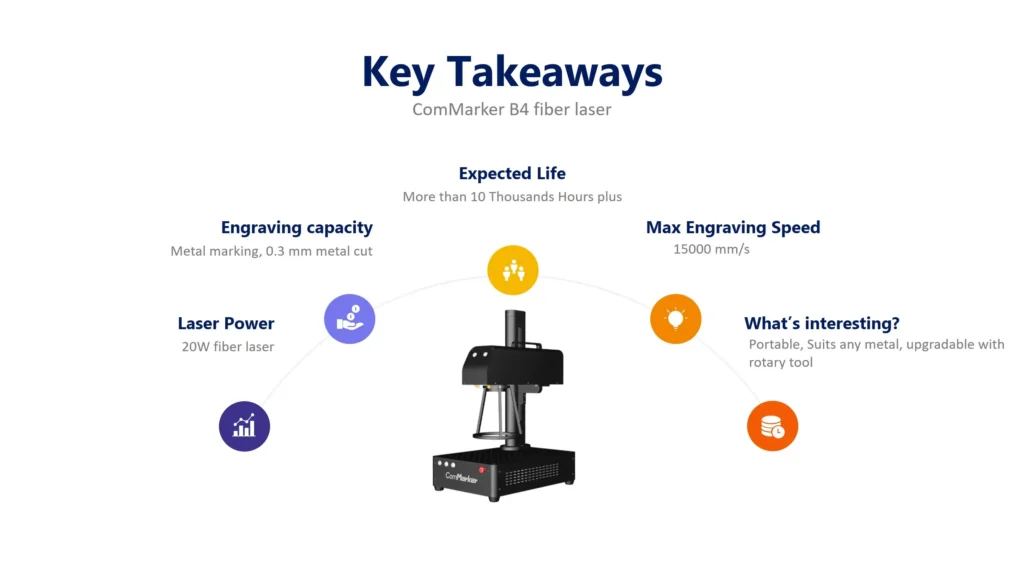
Considering the 15000 mm/s engraving speed, you can easily imagine how fast this portable fiber laser can laser mark a metal piece.
Below is an experiment, done with ComMarker B4. As you can see, it took only 14 seconds to make a complete metal laser marking.
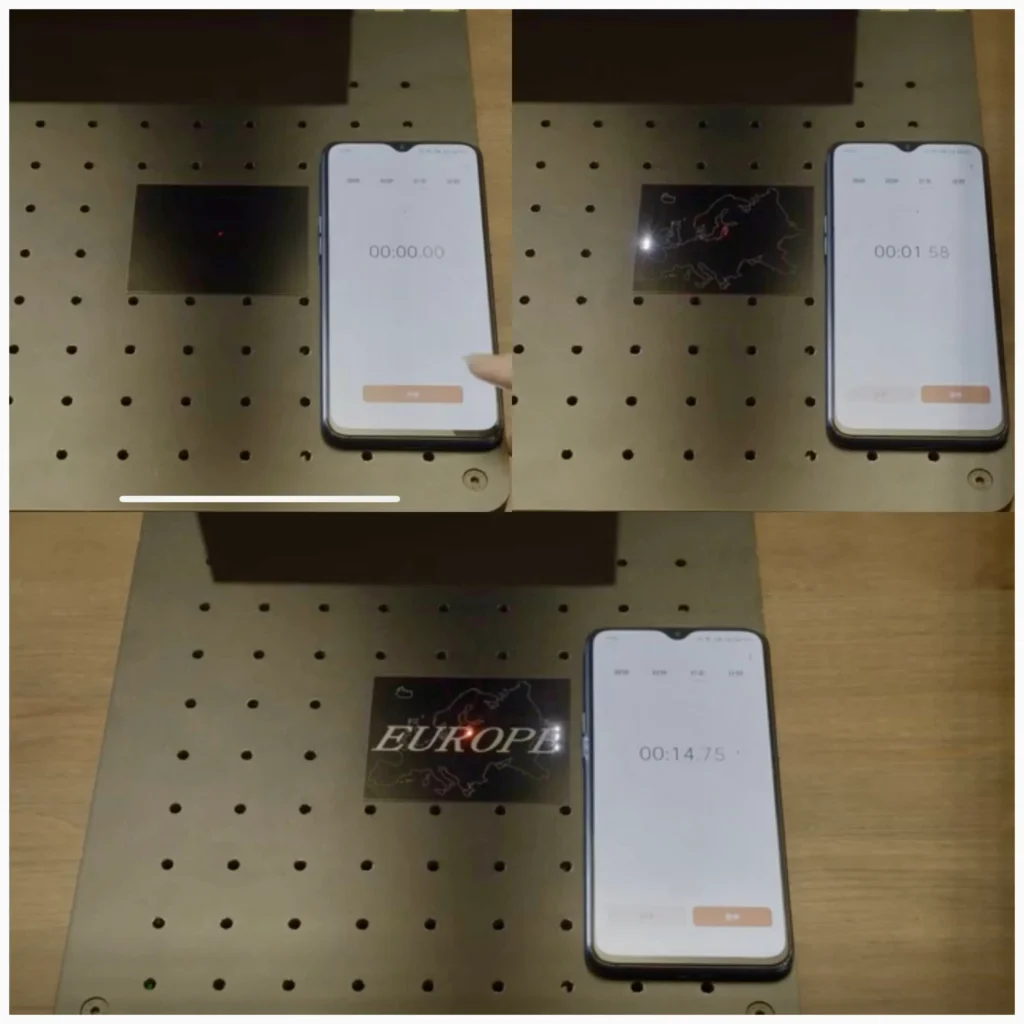
By using a thermal effect, controlled ablation through ComMarker’s pulse duration, pulse frequency, multiple passes, and overlap, you can easily create white metal marking on the anodized metal, or white engraving with the black background.
LaserPecker LP4 Portable Laser
LaserPecker’s LP 4 is only available to some bloggers like us, and their shipping schedule starts in 2023 mid-august. As per the test trial, below is our experience with the LP 4 handheld laser engraver.
LP 4’s capacity is slightly lower than the xTool’s F1, having a maximum engraving speed of 2000 mm/s. It’s also available with rotary attachment and slide extensions but at a premium price.
From the design & appearance aspects, LP 4 is a beast having a small touch screen for easy navigation. The accuracy we got was as low as 0.003 mm which is slightly lower than what xTool f1 had. However, the laser engraving quality was amazing and ready to beat any other portable laser engraver in the market. Besides the tiniest accuracy level, the LP 4 can engrave at a resolution of 8K HD, which is way above the other laser engravers currently available.
There are two lasers one being a 10W blue diode laser that generates 450nm wavelength to work on general materials and the other being a 2W IR laser with a capacity of generating 1064 nm wavelength laser light. Such 2 W IR laser is quite similar to the pulsed fiber laser that can engrave harder materials such as stainless steel, gold, silver, platinum, and plastics.

Considering the engraving speed, accuracy, and laser quality, the LP 4 strongly competes with the xTool F1. However, some other features help Laserpecker to stand out among the intense competition.
LaserPecker 4’s differentiating factors
In the top digital display; the user can monitor the engraving progress as well as switch the laser module as per their needs. Besides, file savings for future access is just a click job with the LaserPecker 4.
Dual laser power supply is surely a premium option in LP 4. Let’s imagine there is a key ring having both stainless steel and leather that needs to be engraved. The LP 4 will first engrave the leather with its 10W blue diode laser and immediately switch to the 2W IR laser to engrave the stainless steel portion. It not only saves your time but also enhances the engraving accuracy as further repositioning of the working material may destroy the alignments.
One feature that completely differentiates LP4 from others is its rotatability. That means the user can take this portable laser engraver anywhere and start engraving from any angle. Alternatively, if the working material is sensitive to movement, we can take this laser engraver there and engrave without even re-positioning the engraving machine. This feature is worth a thousand dollars because many of us want engraving anywhere.
Here’s a gold ring engraved by the LaserPecker LP4:

Apart from vertical engraving, we could also become successful in vertical rotary engraving. Wait a minute! what does that mean?
It means if there is a cylindrical flower vest standing anywhere, you can take the LaserPecker’s LP 4 there, and it will start engraving using the rotary not even changing the vertical position of the flower vest. Undoubtedly, this is a market-dominating feature that is not even available in xToll F1 and Atomstack’s M4.
Above all, the engraving speed is again a winning factor that made LP 4 5 times higher in wood engraving than the others in the market engrave wood at around 400 mm/s. However, the multi-task syncing feature further empowers the speed to boost productivity. For example, this handheld laser engraver can engrave and cut the borders in a single run which saves crafting time and boosts effectiveness.
The safety features are also premium compared to older LaserPecker modules, as the LP 4 introduced tilt protection and a triple laser filter which protects both working material and the outside environment peacefully. Other than these, there is overheating protection and an emergency stop button to handle any unfavorable situations.
Here are more engraving works done by the LaserPecker L4:
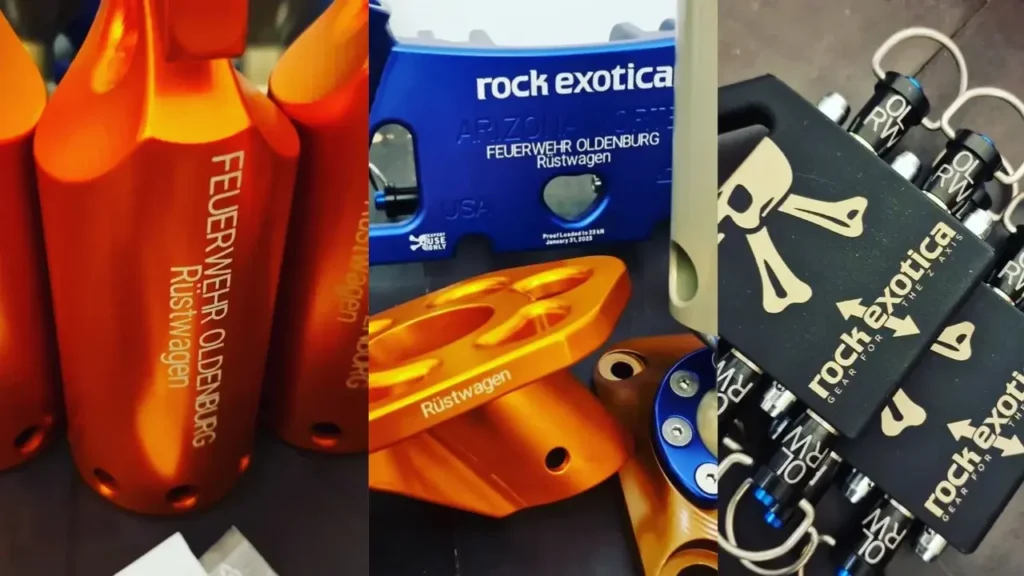
How Does Laserpecker 4 differ from older LaserPecker handheld lasers?
As said earlier, LP4 is the first to introduce a rotating laser head as per the material’s need. LaserPecker had 3 previous handheld laser engravers, which could successfully introduce portability but not dynamic portability.
Coming forward, LaserPecker 4 added the dual laser power that was not available in earlier versions. So, with this model, the manufacturer rolled out its portable engraver as an indirect alternative to the pulsed fiber laser for small crafters.
In addition, the slide extension and vertical rotary attachment is the new addition that LaserPecker 4 marketed successfully. The work bed of LaserPecker 4 is higher than earlier versions being 120 x 160 mm which is further expandible to 300 x 160 mm with its upgradable slide extensions. It means, someone with LP 4 can even do the batch processing of laser engravings but for a limited number.
Lastly, the LaserPecker 4 introduced a dual exhaust fan on top of it that sucks the smoke and eliminates the need for an additional smoke purifier.
Here are tumbler engraving we did with the LaserPecker handheld lasers:
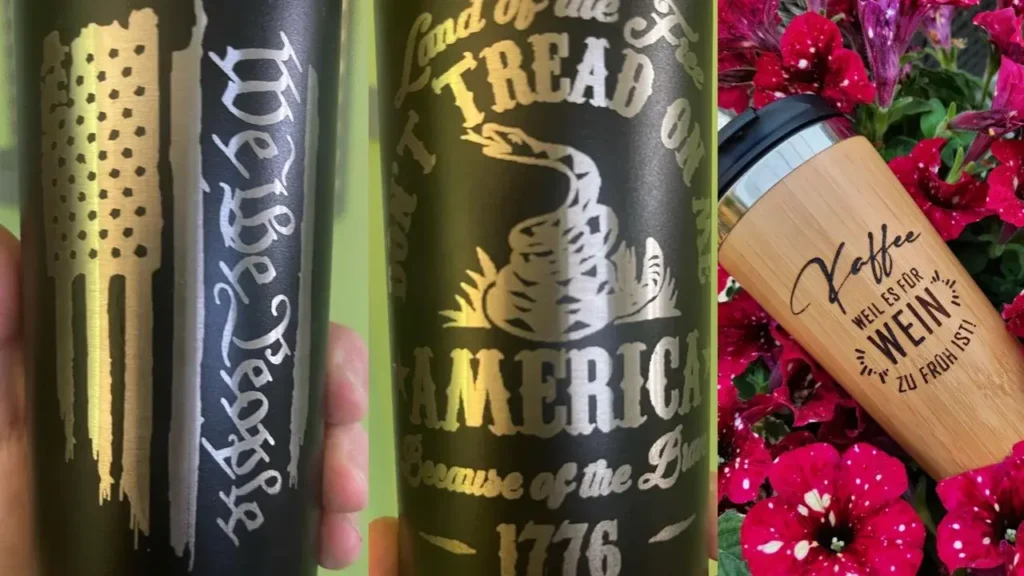
Key Takeaways of LP 4
- Dual Laser power, one being a 2W IR laser helps in stainless steel to green leave engraving
- The multi-laser syncing feature makes the job easier. Efficient while you need to engrave something having two types of heat-sensitive material.
- Rotates according to the material position (you don’t need to place the material as per the laser’s position)
- Faster Engraving speed of 2000 mm/s
- 0.003 precision (higher than Attomstak M4)
- Upgradable with rotary & slide extension
Pros
- Engraves anywhere with its rotation ability
- Engrave at 8K HD resolution
- It’s tiny and smart
- Runs at low noise
- Cuts up to 8mm of wood
Cons
- Cannot cut thicker wood
- Working bed height is limited to 160 mm
- Batch processing is possible but limited to fewer numbers
Enjoywood portable laser
Enjoywood is a handheld (two-in-one) laser engraver that offers 4K engraving accuracy with a precision rate of 0.001 mm. It’s a lightweight portable laser engraver that features a 2W IR laser. Even though the manufacturer markets the product by saying a fiber laser actually, it isn’t. However, marketing tricks are okay if the laser can engrave said material types including plastics, stainless steel tags, and even gold.
The laser marking speed here is 12 m/s which is significantly less than the F1, LP4, and LX1. However, this portable laser marking machine is suitable for someone who just needs to work with laser marking.
For instance, someone with this handheld laser marker can engrave jewelry, spoons, metal tags, and plastic materials (headset and smartphone charging head). This is a great customizer that works with a 1064 nm wavelength laser.
However, you cannot engrave large pictures or cut wood and leather with this machine as this is purely designed for laser marking jobs.
Like the LaserPecker LP 4, you can take this anywhere to put laser marks. There is a laser beam protector which limits the laser beam reflection which may cause injury.
While testing this laser marker, it appeared as an identical copy of the Attomstack M4 since everything in this portable laser engraver matches the Attomstack M4’s specs.
Assembly doesn’t take much time since everything comes organized and written instructions are there.
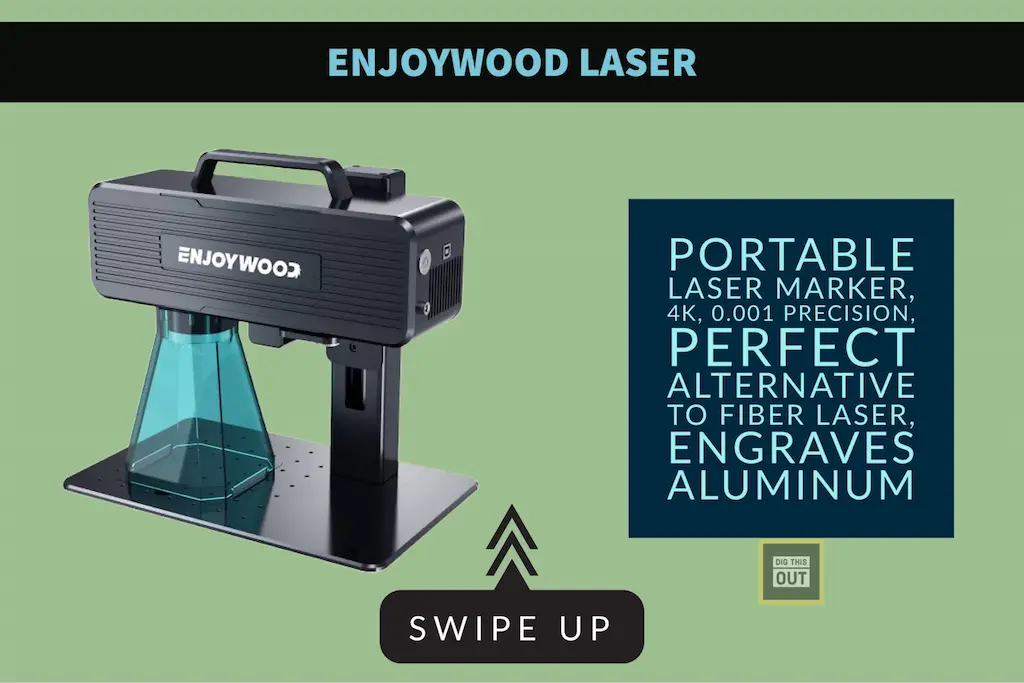
Enjoywood is an engineering company mainly specializing in woodworking technology. Earlier, they sold so many items of diode laser engraver which was a basic DIY laser engraver with affordable price.
The portfolio suggests that the company makes these machines through the OEM (Original Equipment Manufacturer) from China. However, This laser marker is a true market cruncher as they have been sold regularly on Amazon and there are only a few negative experiences noted.
The company did not make a significant rollout from their earlier machine; however, the performance of this laser engraver is really good and it is worthy to be in the list of the best portable laser engravers.
Here’s is a fishing wheel engraving done with Enjoywood metal engraver:

What makes Enjoywood Special?
Enjoywood is not a traditional laser cutter or even an image engraver. This is only designed for laser marking which means you can place laser marks anywhere without thinking about the types of materials except laser cutting and large picture engraving.
It’s so handy and sturdy especially it fits anywhere to put the laser marks on.
Even though it is sold at a price that is lower than Attomstack M4, we suggest you go for it since the Attomstach costs higher and Enjoywood is an identical copy of the same M4 by Attomstack.
Here’s an example of apple earbuds engraving done with Enjoywood:

Pros
- It’s a professional portable laser marker
- Precision is as low as 0.001 mm
- Service life is as much as 20 thousand working hours which is considerably higher than others.
- laser marking resolution is 4K which means any logo or pattern engraving will be accurate at its max
- Its handy and supports almost every file type
- Engraves Aluminum allow and stainless steel
- Easy operation
- Affordable alternative to fiber laser engraving
Cons
- Cannot cut or engrave large pictures
- Engraving speed is slower than LaserPecker & xTool
Attomstack M4 Portable Laser Marker
Attomstack M4 is a sturdy yet handheld laser marker with a 20W IR laser specially designed for laser marking jobs. It also offers a laser wavelength of 1064nm which is suitable for engraving or laser marking metal, alloys, and metal oxide.
This portable laser engraver ensures an accuracy level of 0.01 mm which seems like an original version of the Enjoywood laser. This laser engraver is lightweight, allowing you to carry it anywhere you need it.
As per our analysis, Attomstack M4 is almost 5 times more efficient than the blue ray laser marker which is bulky as well as more expensive than this. Additionally, with this 20W IR laser module, you can engrave plastic or metal items with a resolution of 4k which is unbelievable.
Below metal engraving below shows how amazing Atomstack M4 was:

Overall, the structure of this laser engraver is made by anodized consequencing lightweight portability. Besides, this laser marker will offer a lifetime of almost 20000 working hours which makes it worthwhile.
If you consider the compatibility, the M4 works with any operating system and supports lightburn. It supports file types such as PLT, DXF, BMP, JPG, and JPEG including Code39, EAN, PDF417, and DM.
the work area is 70*70mm which is enough for laser marking. However, there is not batch processing option, nor is there a slide extension feature like the xTool F1 and LaserPecker LX1.
Overall, Attomstack M4 is a true handheld laser engraver that is available for nearly $1000 with a capacity to engrave just anything including hard metal.

Additional information on Atomstack M4
This portable laser engraver can travel 11 CM in X axes which is more than enough if you compare stainless steel or allow engraving tasks. However, you may also take advantage of its removable work plate which will offer you higher space from the contact point if needed.
The M4 arrives in a semi-assembled version that eliminates assembly time by 50% compared to other laser engravers such as xTool D1 pro or Raycus fiber laser.
How is Atomstack M4 different than other Atomstack Lasers?
If you have a closer look at Atomstack’s laser machine portfolio, there are hefty numbers of diode lasers that strengthened the company’s overall know-how in this industry. Even though Atomstack is still fighting with its innovation to other similar competitors like xTool & LaserPecker, still it earns customers’ loyalty with its low-cost laser module.
Atomstack M4 is the very first smart yet handheld laser engraver but there is another version which is called MR 20 that has the capacity. Also, The MR 20 is only designed to place small laser markings whereas the M4 offers you a choice of either to laser mark or laser engrave at 4K.
Additionally, Atomstack also sells an IR laser module that easily fits in their diode laser set offering DIY laser crafters a chance to engrave at 1064 nm. However, there are a lot more chances of bringing innovation if M4 is compared with portable laser machines such xTool F1 and LP4.
Below is an example of Atomstack’s plastic engraving quality:
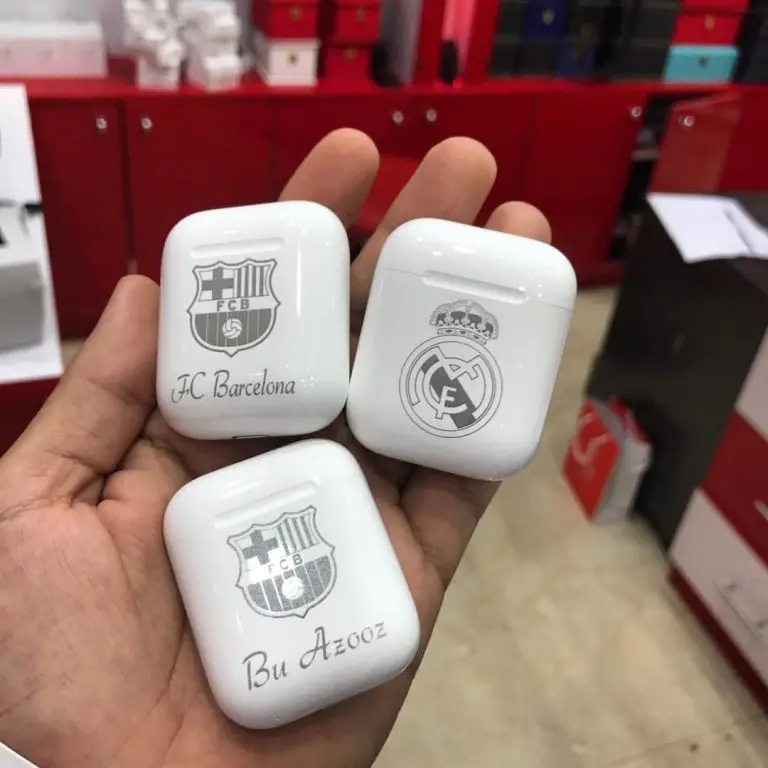
Attomsatck M4 or LaserPecker LP4?
As said earlier, Atomstack M4 is a specially designed laser engraver targeted for laser marking enthusiasts. For example, someone only looking to engrave a logo on a stainless steel plate or someone wants to engrave in clocks, I pad, glass, etc.
On the other side, the LaserPecker LP4 is a combination of both laser engraver and laser marker with maximum portability. The LP4 from LaserPecker can either Cut or engrave of laser mark at 1064 nm whereas the Atomstack M4 cannot do laser cutting & large engraving.
Batch processing seems to be a weakness of Atomstack M4 as there is no such feature. They have completely focused it to make it fully handheld assuming that the user will take the machine on top of the material whereas the LaserPecker brought both of them.
The LaserPecker lasers are easy to travel to working material, they rotate according to the material’s position as well and do the batch processing with is slide extension rail.
Additionally, LaserPecker lasers are expensive due to offering dual laser sync which means the single machine immediately switches between its two laser sources (diode and IR) whereas the Atomstack M4 does not have such flexibility. Alternatively, this lack helped it to be cheaper than others as there are a few customers who cannot afford to incur 2 thousand of bucks on a single handheld laser engraver.
We must say that Atomstack M4 and LaserPecker LP4 are two different laser engravers targeted to different user groups. However, considering the price point, Atomstack M4 must be worth a try whereas any person looking to explore so many ideas of laser engraving & laser marking may go for the LaserPecker.
Sculpfun Icube portable laser
We tested the Sculpfun Icube Pro 10W laser which has been pretty decent in terms of appearance and portability.
The Icube Pro is a portable laser with a 3W/5W/10W diode laser option (based on which the price varies). The engraving speed we got was around 166 mm/s which is not so lucrative but from the price point, it’s okay for the beginners.
The Icube can engrave suitable diode laser materials such as wood, MDF, and acrylic. However, it cannot cut more than 1/4 inch of wood (even if it takes multiple passes for cutting wood).
If you are searching for a portable laser for straightforward engravings then the Icube can be an option.
However, it cannot engrave stainless steel or plastics like the F1 or Atomstack.

Key Takeaways of Sculpfun Sculpfun Icube
- Diode laser only (455 nm wavelength)
- Suitable for wood and diode, leather, and other friendly workpieces
- Weighs around 11 lbs
- Budget-friendly (price starts from USD 250 as it varies depending on the laser power)
- Precision 0.02 – 0.08 (No autofocus)
- Supports Lightburn
Positive sides
- It’s portable, lighter than the F1
- Upgradable with air assist and air purifier, which is a must for leather engraving
- It’s compact with a dimension of 300*262*226mm
- Accompanies dustproof laser nozzle that helps a lot by protecting the laser from debris
- Contains temperature sensing intelligence that is super helpful in case of any chance of fire incidents
- There is a protective shield attached so no additional enclosures would be required
- The basic smoke filter is built-in but you can buy the air purifier additionally
- Cuts up to 10 mm of wood (sometimes multiple passes would be needed for hardwoods)
Negative side
- Not as precise as the xTool F1 & Laserpecker 4
- No power station attached
- Cannot engrave stainless steel due to not having an infrared laser option
Final opinion
Overall, the Sculpfun Icube can be a good portable laser under budget. It is more suitable for beginners. Perfect budget-friendly portable laser engravers to start engraving at home.
Benefits of Handheld Lasers
Handheld laser engravers are famous due to several advantages as follows:
Portability is the most significant advantage of handheld lasers compared to desktop lasers. You need to bring the working material under the laser head or inside the laser engraving machine to engrave on that particular material.
Handheld lasers just require designs with either a pen drive or connecting cable, and the user has the freedom to place the machine where it needs to work.
Usually, portable laser engravers contain a battery to move them anywhere, but obviously, they also run through connected power. You can take the example of the Laserpecker 4, which rotates its laser head 360 degrees, has a battery backup, and is also suitable for engraving anywhere.
The best example here would be engraving outdoor furniture or a metal plate that you cannot bring to your workstations. In some cases, such as trade shows or mini stores, where enormous demonstrations or services are done, could be efficiently served by the portable laser engravers.
Capacity enhancement is also a positive side of handheld lasers. Let’s take an example of stainless steel engraving, which needs expensive fiber laser markers.
Usually, the diode laser should have a wavelength of 465 nm, which is insufficient for engraving stainless steel. With emerging technology, people now have the freedom to engrave metal tags with a portable handheld laser with its IR laser head that even delivers laser power at over 1300 nm wavelength.
For example, the xTool F1 comes with two different laser heads, one with an infrared laser that helps to do the stainless steel engraving and the bare metal brass engraving.
Portable laser engravers are also cheaper than similar powerful desktop engravers. Let’s take the example of a bakery that needs to engrave the package or the cake itself to get the premium price in exchange for the customization done for the customers.
The owner cannot afford to incur $5000 over the laser machine since the only job is to engrave the customer’s name over the package. Handheld laser engravers become useful here with a moderate investment that gives the owner a faster return on investment.
Negative sides of portable lasers
There are some negative sides of the handheld laser engravers as well, which are addressed below:
Usability: Not all types of portable laser engravers work for all material types. For instance, the xTool F1 and the LaserPecker 4 works for all types of material but the ComMarker B4, Atomstack, and Enjoywood only work in stainless steel, certain wood types, plastics, and other metals. So, knowing what you need can contribute to your engraving journey.
Handheld lasers are risky. Working with laser engravers is always risky because premium lasers are sold in canopied versions.
The open lasers are only recommended for DIY crafters who know very much about the risks or have necessary precautions at their workplace. Buying a handheld laser may benefit you with tons of potential but may lack safety features compared to the canopied laser machine.
For instance, the xTool P2 holds the ability to detect fire and even integrates with the fire protection system, whereas the xTool F1 would require a separate smoke purifier just for being a handheld device.
Similarly, portable lasers are not quite as heavy as the bigger ones. For example, a portable diode laser can easily be engraved on wood anywhere, but it cannot be engraved on a larger wood piece. For example, you may engrave a small photo over a 24-inch wood piece with portable diode lasers, but engraving the entire 24-inch would need a stable machine such as xTool D1 pro or the xTool P2.
Handheld lasers cannot always cut like the desktop laser machine. If cutting wood or acrylic is your priority, then handheld laser engravers may not be suitable. Upgradability is also a concern for portable lasers. In a desktop laser, you can either replace or upgrade the laser head having the flexibility to upgrade the working bed itself, which is impossible in portable diode lasers. For instance, the Atezr P10 and xTool D1 Pro can be extended by the extension kit, but the xTool F1 cannot to that big dimension.
How should you choose a Handheld Laser Engraver?
Choosing a handheld laser engraver might sound simple as there are so many versions available in the market. Besides its power, capacity, and material compatibility, there are a few issues that you should look at before buying a handheld laser engraver.
In this article, we will try to analyze your needs and offer an expert guide to choose the right handheld laser engraver for you.
What’s your need?
Before choosing a handheld laser engraver, you first need to assess your needs. For instance, you need to analyze whether you need a laser marker or a laser engraver. Other than that, you might end up buying the wrong product even at a higher price.
A laser marker is typically a fiber laser or an infrared laser which can print marks on the hard surface such as stainless steel, aluminum, plastic, gold, and platinum. So, if you need to print a logo or any pattern on the metal tag and plastic, a laser marker will do the job.
The main difference between laser marking and laser engraving is the depth of the pattern. Usually, a laser marker prints the pattern on the material surface with no penetration or very little penetration. In comparison, a laser engraver penetrates/burns the material slightly to place the patterns through etching.
Questions might come such as – how the laser marker places the design without burning or penetrating.
The method of laser marking on stainless steel and titanium is called ‘Annealing‘ where the heat generated from the laser beam results in oxygen diffusion underneath the material which further creates oxidization and color change. The perfect example of annealing is the small printed logo we see on the fork or the tablespoon.
There is another way of laser marking in the metal and metal allow items which is called ‘Laser Carbon Migration‘. In this process, the laser beam sends carbon in a forced manner to the material surface which results in darker laser marking.
In a nutshell, If you do not want the material to get burned or penetrated heavily, you need a true laser marker which can either be a fiber laser or a handheld laser marker such as ComMarker B4 and Atomstack M4. On the other side, if you need a portable laser machine to perform etching and laser engraving through slight, medium, or heavier penetration then the true laser engraver will be the option for you. In this case, you can go with either the xTool F1 (the fastest portable laser of 2023) or the LaserPecker LP4 which comes with higher versatility.
If you are not sure of your need, we suggest you buy a handheld laser engraver such as xTool F1 or something similar that can perform both laser marking and laser engraving in different types of material. Choosing such a multi-function laser engraver will have one disadvantage You cannot perform laser marking like the professional fiber laser which is why we referred to the Atomstack M4 for the professional laser markings.
Be aware of power
Looking at the laser power is the next thing you should do. There are plenty of handheld laser engravers available in the market it becomes difficult to choose one, especially for beginners. Handheld laser engravers such as xTool F1 and the Laserpecker LP4 come with dual lens technology where one laser head appears with a 2W infrared laser for laser markings whereas the other blue diode laser performs laser engravings.
However, Professional handheld laser markers such as Enoywood or Atomstack have the power of 20W IR laser which can reach up to 2000W with pulse peak optical power technology.
In laser marking, the pulse peak optical power refers to the maximum power of an individual laser pulse. It’s a crucial parameter because the intensity of the laser pulse determines how effectively it interacts with the material being marked.
For a better understanding, you may look at the differences between the Q-switched laser and MOPA fiber laser. Laser marking involves creating marks, patterns, or engravings on a surface using a high-energy laser beam. The ability to achieve a high pulse peak optical power has significant implications for the marking process.
What is High Pulse Peak Optical Power?
A 20W IR (Infrared) laser reaching up to 2000W pulse peak optical power might seem counterintuitive, but this phenomenon is a result of pulsed laser operation. While the average power output of the laser might be 20W, the laser can generate very short bursts of incredibly high power during each pulse. This is achieved through a technique called pulse shaping or pulse modulation. This is why a professional marker generates perfect laser marking on the stainless steel through annealing whereas the normal laser engravers cannot.
For example, imagine a 20W IR laser that emits pulses that are only 1 microsecond (μs) in duration. The energy of each pulse can be calculated by multiplying the power (20W) by the pulse duration (1 μs), resulting in 20 microjoules (μJ) of energy per pulse. Now, if these pulses are generated at a rate of 100 kHz (100,000 pulses per second), the average power remains 20W, but during each microsecond pulse, the power momentarily spikes to 2000W (20 μJ / 1 μs).
This high pulse peak optical power is crucial for laser marking, especially when dealing with materials that are hard to mark or engrave. When the laser pulse interacts with the material’s surface, the high intensity enables efficient ablation, vaporization, or modification of the material, resulting in a clear and well-defined mark.
Frequently Asked Questions
The following are the frequently asked questions related to handheld laser engravers. We tried to answer each so that the relevant information is ready for you.
There’s also a detailed buying guide that you should consider before choosing a portable laser engraver.
What is the cost of a mini laser engraver?
Mini or portable laser engravers may cost you from $200 to $2500 depending on their capacity and intelligence. For example, there are some handheld laser engravers like a pen available at around $100 to $250. These mini engravers are etching tool that are used by crafters to etch leather or other items. Notably, those etching machines cannot engrave at given patterns as the mini engraver’s maneuver is done on the human hands. On the other side, mini laser engravers like xTool F1 and Atomstack M4 are purely handheld but can engrave any material. These machine operates with computer programming and automatically adjust power, focus, and accuracy intelligently.
Can a handheld laser engraver cut metal?
Handheld laser engravers are not meant to cut metal, though they can cut metal if appropriate laser power is introduced in the portable machine. If you consider the price of a handheld laser engraver, it stays around $500 to $1500 which cannot bring such powerful laser power for you to cut metal. In a nutshell, portable laser engravers are used to engrave different materials, usually smaller pieces, and perform laser markings on top of the metal, metal alloys, and other sensitive materials through the 1064 nm wavelength laser power generated by IR lasers.
Can Handheld laser engravers cut wood?
Yes, the handheld laser engravers cut wood, acrylic, leather, and fabric. Cutting ability purely depends on the laser power and their respective ability. For instance, xTool F1 and LaserPecker L4 are two of the finest mini laser engravers which cut wood up to 10mm. Since these handheld lasers use both diode and IR laser modules, so laser cutting is done by the diode laser, and metal engraving is delivered by the IR laser.
However, not all portable laser engravers can cut. For example, the Atomstack M40 is a single 20W IR laser-based engraver that only engraves and laser marks. It cannot cut anything because IR lasers deliver laser at 1064 wavelength which is an invisible range. On the contrary, diode lasers use 465 nm wavelength which effectively cuts wood and other materials.
Do Laser Engravings Last?
Yes, laser engraving lasts for a longer time unless the material is destroyed by something else. In general, the longevity of laser engraving depends on the material being engraved, the conditions to which it is exposed, and the quality of the engraving itself. For example, metal engravings done by the fiber laser or IR lasers last for an infinite time unless the material comes into contact with harsh weather or fractions resulting from any other materials. Glass engravings also last for a lifetime till the glass itself gets destroyed. We recommend you use the right laser engraver so that the power, depth, and focus remain accurate which directly affects the longevity of the engraving.
Why should you trust us?
Hundreds of other blogs wrote about the same topic earlier. So, why should you trust us?
To be honest, we tested these laser engravers and scored each of them as per our standard scoring tool. The scoring mechanism not only contains speed, precision, and power but also considers other parameters such as customers’ satisfaction, material compatibility, and other productivity factors.
We also cross-match our actual findings to whatever the manufacturers wrote in their website. So, trusting us would be beneficial for you as we follow strong ethics while writing a review.
Most importantly, we never accept any sponsored review as it would likely harm our readers’ confidence in the future.
Whatever is bad, we dare to tell them as bad. So, you can trust our team’s expertise and experience.
Conclusion
Handheld laser engravers can now do the job of large laser engravers due to emerging technology and other intelligence. We strongly recommend you know your needs and choose the right laser engraver accordingly.
